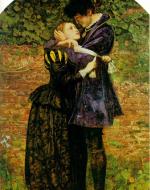Created by ellie stringham on Thu, 10/06/2022 - 14:14
Description:
The Pre-Raphaelite Brotherhood was a group of young English painters founded in the year 1848, relatively new for the Victorian Period. The group was founded in a strong reaction against the Royal Academy of Art. The leaders of the movement saw the Royal Academy as unimaginative and too reliant on its own history. This counter-culture movement was inspired heavily by Italian art in the 14th and 15th centuries, specifically the Italian renaissance before the artist Raphael, giving them the name “The Pre-Raphaelite Brotherhood”. The movement was spearheaded by three artists John Everett Millas, Dante Gabriel Rossetti, and William Holman Hunt. All of whom were under the age of 25 at the time. The Brotherhood gained several more members such as painter James Collinson, painter and art critic F.G. Stephens, and sculptor Thomas Woolner.
The group focused heavily on subject painting, using Medieval and religious figures as well as characters from various fictional settings. Their style was very emotional and evokes a great sense of innocence and naivety they found prevalent in the 15th-century Florentine and Sienese paintings. Another hallmark of the Pre-Raphaelite painters was an intense poeticism that does not often appear at first glance, leading to a strange intimacy between the art and the viewer. John Everett Milla’s painting “A Huguenot” is a perfect example of this. On the first viewing, the viewer sees only two lovers dressed in 16th Century costumes locked in a passionate embrace. The girl tries to tie a white armband over her lover’s arm as the boy cradles her head as he pulls her hands away. This interaction could be dismissed without knowing the entire story of the two. A further deep dive tells the story of the St. Bartholomew’s Day Massacre, where 3,000 French protestants called “The Huguenots” were murdered for not declaring their allegiance to Catholicism. A select few were able to escape the massacre by tying white armbands around their left arm to show their allegiance to the Catholic Church. This added depth is not given over to the viewer immediately. Rather the paintings and sculptures of the Pre-Raphaelite Brotherhood are allowed to exist as they are and rely on the viewer to discover their purpose.
Much of the artist’s early work was submitted anonymously or under the pseudonym PRB, fearing the backlash of the Royal Academy of Arts as well as the English art world itself. Their identity was ultimately discovered in 1850, and many established artists and critics were very distrustful of their youth, thinking they were too young to create any art of meaning. They were critiqued harshly by many prominent people including the novelist, Charles Dickens. Most of the criticisms were against their idea of objective beauty. During the early Victorian period, there were detailed outlines of academic beauty, the Pre-Raphaelite Brotherhood challenged this notion with their works of art. They were also criticized for their religious work as well. Many of their paintings and sculptures depicting a religious ideology are bathed in a sense of realism as well as their dreamlike and fantastical approach. This was deemed as almost disrespectful of the church as well as the bible because most other works of art depicting a religious scene had a mask of spiritual fantasy in order to create an otherworldly or heavenly look to the art.
The Pre-Raphaelite Brotherhood only lasted about five years, although they were never formally disbanded. Most of the artists had simply gone their separate ways and focused on their own projects. Millas grew into a great academic success, and while the others did also see high acclaim, he was the one to grow the biggest in fame. Dante Gabriel Rosetti also continued to paint and turned to writing poetry as well. He eventually put a lot of focus on teaching younger artists and pivoted to a more mystical approach to his art. William Holman Hunt also continued to paint but never saw a big change in his own art. He mostly stuck to the Pre-Raphaelite principles. The effect that the Pre-Raphaelite Brotherhood had on the Victorian art world was widespread and prolific. Their artistry was widely copied and is now considered some of the greatest in the western world. Their art is often looked at as a hallmark of the Victorian Era. This young group of artists embodied the legacy of the era, their drive changed much of the art world and grew to become a great time of progress. Much like the Victorian Era itself, their ingenuity created new lifeblood to the style of the time. The Victorian era, like this group of young artists, was also one of many changes that grew England into the powerful empire it was.
Works Cited:
“Pre-Raphaelite Brotherhood.” Encyclopedia Britannica, 14 Sept. 2022, www.britannica.com/art/Pre-Raphaelite-Brotherhood.
Meagher, Jennifer. “The Pre-Raphaelites.” In Heilbrunn Timeline of Art History. New York: The Metropolitan Museum of Art, 2000–. http://www.metmuseum.org/toah/hd/praf/hd_praf.htm (October 2004)
Tate. “Pre-Raphaelite.” Tate, www.tate.org.uk/art/art-terms/p/pre-raphaelite. Accessed 4 Oct. 2022.
Copyright:
Associated Place(s)
Part of Group:
Featured in Exhibit:
Artist:
- John Everett Millais


